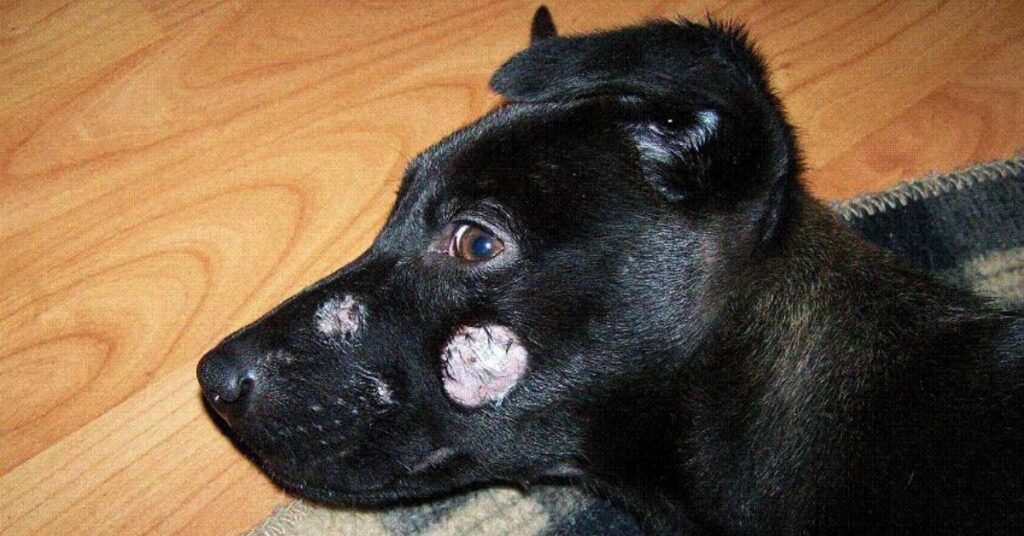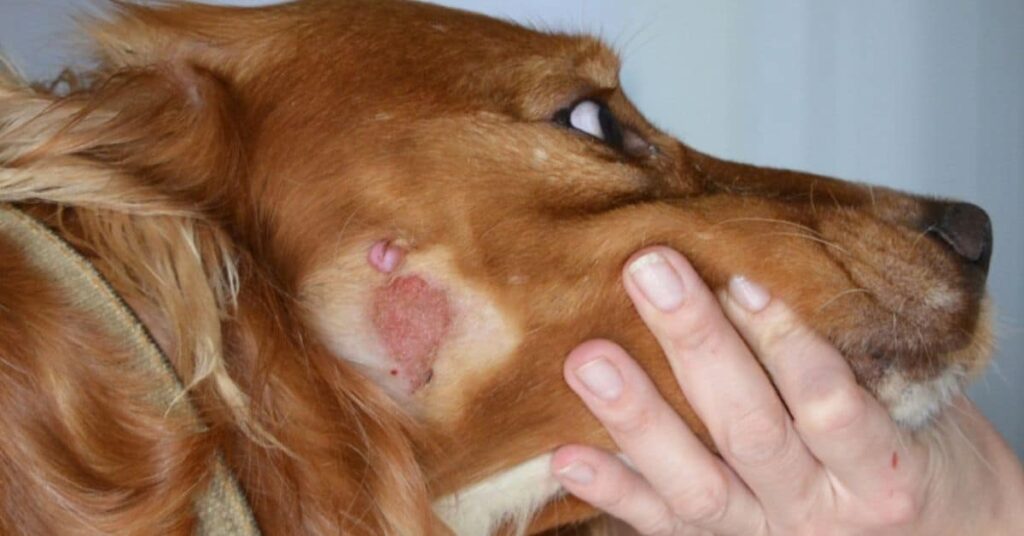Contrary to its name, ringworm in dogs is not caused by a worm at all. It is a fungal skin infection known as dermatophytosis. The fungi that cause ringworm belong to a group called dermatophytes, which feed on keratin – a protein found in hair, nails, and the outer layer of skin.
Ringworm gets its name from the distinctive ring-shaped rash it can cause on human skin. However, the appearance of ringworm on dogs can vary widely depending on factors like the infecting fungal species and the dog’s immune response.
Common Ringworm Symptoms in Dogs
While ringworm may sometimes cause the classic ring-shaped lesions, there are various other potential signs to look out for in dogs. Common symptoms of ringworm in dogs include:
- Circular patches of hair loss (alopecia) with crusty or scaly skin
- Inflamed, reddened, or darkened skin
- Excessive dandruff or scaling
- Brittle hair shafts that break easily
- Itchy, irritated skin
- Raised, fluid-filled bumps or lesions
- Thickened, cracked, or abnormal nail beds
The severity can range from just a few isolated lesions to widespread rash and hair loss over large areas of the body. Puppies, senior dogs, and those with weakened immune systems are especially vulnerable to more severe infections.
What Do Ringworm Lesions Look Like on Dogs?
Ringworm lesions can have several different appearances on a dog’s skin and coat. Some of the most common presentations include:
Circular Patches of Hair Loss
One of the more recognizable signs is the development of circular areas of alopecia (hair loss) with a crusty, scaly outer ring. These coin-shaped lesions may start small and gradually expand outwards.
Irregularly-Shaped Patches
Rather than following the classic ringed pattern, the hair loss and scaling may occur in more irregularly-shaped patches, especially if the infection covers a larger area of skin.
Scaling and Dandruff
Heavy accumulations of dry, scaly skin resembling severe dandruff can also be a sign of a ringworm infection, especially when accompanied by hair loss or redness.
Inflamed Lesions
Some forms of ringworm cause raised, reddened, pus-filled bumps or lesions that may resemble bacterial skin infections.
Hyperpigmented Skin
Ringworm patches sometimes appear as thickened areas of darker or hyperpigmented skin, particularly in dogs with naturally darker coats.
Nail Abnormalities
The fungi can invade the nail beds, causing thickened, cracked, brittle, or abnormally shaped nails.
Also Read This Blog
Where Does Ringworm Most Commonly Appear?

While ringworm lesions can develop anywhere on a dog’s body, they are most frequently seen in certain areas:
- Head, ears, and muzzle
- Paws and nails
- Lower canine legs
- Abdomen and underside
- Base of the tail
Areas with minimal fur coverage tend to be more prone, as the fungi can penetrate the skin more easily. Dogs may also excessively lick or scratch affected spots, potentially spreading the infection further.
Risk Factors for Ringworm in Dogs
Any dog can potentially develop a ringworm infection, but certain factors increase the risk:
- Age: Puppies and senior dogs tend to have weaker immune defenses
- Dense coat: Fungi can thrive in a heavy, moisture-trapped undercoat
- Crowding: The infection spreads easily between shelter, kennel, and multi-pet dogs
- Exposure: Contact with infected animals, humans, or contaminated objects like grooming tools
- Weakened immunity: Dogs with underlying conditions like Cushing’s disease
Ringworm is considered a zoonotic disease, meaning it can pass between different animal species as well as from animals to people.
How to Diagnose Ringworm
If you suspect your dog may have ringworm, seek veterinary attention promptly. Delaying treatment increases the risk of the infection spreading.
To diagnose ringworm, vets rely on:
- Clinical appearance: The vet examines skin lesions and coat condition
- Fungal culture: Plucked hairs or skin scrapings are cultured to identify the specific fungus
- UV Wood’s lamp: Ringworm fungi may glow green under ultraviolet light, aiding visual detection
- Microscopic examination: Viewing samples under the microscope can reveal fungal spores
An accurate diagnosis helps guide the most appropriate treatment regimen for the particular ringworm species involved.
Treating Ringworm in Dogs
Ringworm is generally treated with a multi-pronged approach:
Topical Therapy
Anti-fungal rinses, dips, shampoos, creams, powders, or ointments help eliminate ringworm spores on the coat and skin surface. Examples include miconazole, clotrimazole, and lime sulfur dips.
Oral Medication
For more severe or widespread infections, oral anti-fungal drugs like griseofulvin, itraconazole, fluconazole, or terbinafine may be prescribed for systemic treatment.
Lyme Sulfur Dips
Concentrated lime sulfur dips are an effective but odorous treatment option. The dip helps kill ringworm fungus while softening crusty lesions. It requires repeated applications.
Shaving Hair
In severe cases, shaving the hair around lesions may be recommended to increase topical treatment penetration and removal of fungal elements.
Environmental Decontamination
Since ringworm spores can linger in the environment, thorough cleaning and disinfecting of bedding, surfaces, and grooming tools is critical to preventing re-infection.
Treatment durations vary based on severity but typically continue for 4-8 weeks, with a few additional weeks of monitoring to ensure full resolution.
Recovery and Prevention Tips
While undergoing ringworm treatment, there are some precautions to follow:
- Isolate infected pets from other animals until fully cleared
- Disinfect and avoid sharing bedding, toys, or grooming tools
- Wear gloves when handling the infected pet
- Vacuum frequently and disinfect household surfaces
To reduce ringworm risk going forward:
- Regularly groom pets and check for signs of skin issues
- Quarantine and test new animals before introduction
- Use pet-safe anti-fungal disinfectants on surfaces
- Maintain overall pet hygiene and boost immunity with proper nutrition
With prompt veterinary treatment, environmental decontamination, and some preventative measures, ringworm is normally treatable and future infections can be avoided.
Conclusion
While ringworm may not always cause the classic ring-shaped lesions, any circular patterns of hair loss, scaling, redness, or bumps on your dog’s skin should prompt a closer look. Early identification and treatment are key to resolving this highly contagious but treatable fungal infection before it can spread further.
Consulting your veterinarian at the first signs will get your furry friend on the road to recovery while protecting other pets and human family members from potential exposure. Patience, vigilance, and following your vet’s recommendations are essential for fully eliminating ringworm from your household.







